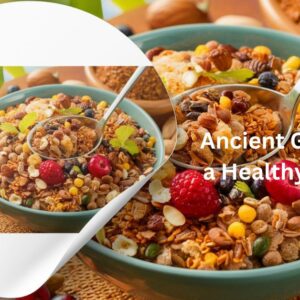Ancient grains have been making a significant comeback in the world of nutrition, especially in the context of healthy cereals.
These grains, which have been cultivated for thousands of years, offer a wealth of health benefits, making them a popular choice for those seeking a nutritious start to their day.
This article delves into the topic of “ancient grain in a healthy cereal” with a special focus on its relevance in today’s health-conscious society, providing insights that go beyond what’s commonly found online.
What Are Ancient Grains?
Ancient grains refer to a group of grains and seeds that have remained largely unchanged over the millennia.
Unlike modern wheat and corn, which have been extensively bred and modified, ancient grains have preserved their original genetic composition, making them a rich source of nutrients. Some popular ancient grains include quinoa, amaranth, spelt, barley, millet, and farro.
The Rise of Ancient Grains in Modern Diets
In recent years, there has been a growing interest in ancient grains, particularly among those looking for healthier alternatives to refined grains.
The inclusion of ancient grains in cereals is part of a broader trend towards whole, minimally processed foods.
These grains are celebrated not only for their nutritional value but also for their environmental sustainability and cultural significance.
Why Are Ancient Grains Perfect for Healthy Cereals?
- Nutrient Density:
Ancient grains are packed with essential nutrients, including fiber, protein, vitamins, and minerals.
For instance, quinoa is a complete protein, meaning it contains all nine essential amino acids, making it an excellent choice for vegetarians and vegans.
- High Fiber Content:
One of the key benefits of ancient grains is their high fiber content, which aids in digestion and helps maintain a healthy weight.
Fiber-rich cereals made with ancient grains can help regulate blood sugar levels and keep you feeling full longer.
- Gluten-Free Options:
Many ancient grains, such as quinoa, amaranth, and millet, are naturally gluten-free, making them ideal for those with celiac disease or gluten sensitivity. This has led to a surge in gluten-free cereals that still offer robust nutritional profiles.
- Rich in Antioxidants:
Ancient grains are often rich in antioxidants, which help protect the body from oxidative stress and reduce the risk of chronic diseases.
For example, buckwheat is known for its high levels of rutin, an antioxidant that supports cardiovascular health.
Ancient Grains: A Brief History
Ancient grains have been a staple in various cultures for centuries. Quinoa, for example, was revered by the Incas as the “mother of all grains,” while spelt was a crucial crop in ancient Europe.
These grains have sustained civilizations through their high nutritional content and versatility in cooking.
How Ancient Grains Are Incorporated into Healthy Cereals?
The inclusion of ancient grains in cereals is not just a passing trend but a reflection of a growing demand for healthier, more natural food options. Here’s how ancient grains are being used in cereals:
- Whole Grain Cereals:
Many brands now offer cereals made entirely from ancient grains, providing a hearty and nutritious breakfast option.
These cereals are often minimally processed, retaining the grains’ natural flavors and textures.
- Blended Cereals:
Some cereals combine ancient grains with other ingredients like nuts, seeds, and dried fruits.
This combination not only enhances the flavor but also boosts the overall nutritional value.
- Granola and Muesli:
Granola and muesli made with ancient grains have become popular choices for those looking for a healthy and satisfying breakfast.
These cereals offer a good balance of carbohydrates, fats, and proteins, making them ideal for sustained energy throughout the day.
Health Benefits of Eating Ancient Grains in Cereal
The health benefits of incorporating ancient grains into your diet are numerous, particularly when consumed in the form of a healthy cereal. Here’s a look at these benefits:
- Supports Heart Health:
Ancient grains are known to promote heart health due to their high fiber content and antioxidant properties.
Whole grains like barley and oats, which are often found in cereals, can help lower cholesterol levels and reduce the risk of heart disease.
- Enhances Digestive Health:
The high fiber content in ancient grains aids in digestion by promoting regular bowel movements and preventing constipation.
Moreover, the prebiotic fibers found in these grains help nourish beneficial gut bacteria, supporting overall gut health.
- Stabilizes Blood Sugar Levels:
Unlike refined grains, ancient grains have a low glycemic index, meaning they have a slower impact on blood sugar levels.
This makes them an excellent choice for those managing diabetes or trying to maintain steady energy levels throughout the day.
- Provides Essential Nutrients:
Ancient grains are rich in essential nutrients like magnesium, iron, and B vitamins, which are crucial for energy production, bone health, and overall well-being. Consuming cereals made with ancient grains can help meet daily nutritional needs.
- Aids in Weight Management:
The combination of high fiber and protein content in ancient grains helps to keep you full and satisfied, reducing the likelihood of overeating.
Including ancient grains in your breakfast can support weight management by curbing mid-morning hunger pangs.
The Environmental Impact of Ancient Grains
Beyond their health benefits, ancient grains also offer environmental advantages. Many ancient grains are more resilient to harsh growing conditions than modern crops, requiring fewer pesticides and less water.
This makes them a more sustainable choice for farmers and a more eco-friendly option for consumers.
Choosing the Right Ancient Grain Cereal
When shopping for ancient grain cereals, it’s important to read the labels carefully to ensure you’re getting a product that aligns with your health goals. Look for cereals that:
- List Whole Grains as the First Ingredient:
The first ingredient on the list should be a whole ancient grain, such as quinoa, spelt, or millet. This ensures that the cereal is primarily made of nutrient-dense grains.
- Are Low in Added Sugars:
Many cereals contain added sugars, which can negate some of the health benefits. Choose cereals with minimal or no added sugars to maximize the nutritional value.
- Contain a Good Balance of Macronutrients:
Look for cereals that offer a balanced mix of carbohydrates, proteins, and fats. This will help provide sustained energy and keep you feeling full longer.
- Are Certified Organic:
Organic cereals are made without synthetic pesticides or fertilizers, making them a healthier choice for both you and the planet.
Ancient Grains Beyond Breakfast
While ancient grains are commonly associated with cereals, they can be incorporated into your diet in many other ways.
Consider adding them to salads, soups, and even baked goods. Their versatility makes them a valuable addition to any meal, offering both flavor and nutrition.
Popular Brands Offering Ancient Grain Cereals
Several brands have embraced the ancient grain trend, offering a variety of cereal options that cater to different tastes and dietary needs. Some popular brands include:
- Kashi:
Known for its commitment to whole grains, Kashi offers several cereals made with ancient grains like quinoa and amaranth.
- Nature’s Path:
This brand offers a range of organic cereals featuring ancient grains such as spelt, kamut, and chia seeds.
- Bob’s Red Mill:
Bob’s Red Mill provides a selection of granolas and mueslis made with ancient grains, offering a hearty and nutritious breakfast option.
How to Make Your Own Ancient Grain Cereal?
If you prefer a more hands-on approach, making your own ancient grain cereal is a great way to ensure you’re getting the best ingredients. Here’s recipe to get you started:
Ingredients:
- 1 cup quinoa
- 1 cup amaranth
- 1 cup spelt flakes
- 1/2 cup millet
- 1/2 cup rolled oats
- 1/4 cup chia seeds
- 1/4 cup flax seeds
- 1/2 cup dried fruits (optional)
- 1/4 cup nuts or seeds (optional)
Instructions:
- In a large bowl, combine all the grains, seeds, and optional ingredients.
- Store the mixture in an airtight container.
- To serve, add 1/2 cup of the cereal mix to a bowl and top with your choice of milk or yogurt.
- Enjoy a nutritious and filling breakfast!
The Future of Ancient Grains in Healthy Cereal
As consumers become more health-conscious, the demand for ancient grains in cereals is likely to continue growing.
These grains offer a nutritious, sustainable, and versatile option for breakfast, making them an excellent choice for those looking to improve their diet.
The future of ancient grain cereals looks bright, with new products and innovations on the horizon.
FAQs
1. Are ancient grain cereals gluten-free?
Many ancient grains, such as quinoa, amaranth, and millet, are naturally gluten-free, making them acceptable for those with gluten sensitivities.
2. What are some examples of ancient grains used in cereals?
Common ancient grains found in cereals include quinoa, spelt, barley, millet, and farro.
3. How do ancient grains benefit health?
Ancient grains are nutrient-dense, rich in fiber, and contain essential vitamins and minerals, supporting heart health, digestion, and weight management.
Conclusion
The inclusion of ancient grains in healthy cereals represents a return to more natural and wholesome food options.
These grains not only offer a wealth of health benefits but also contribute to a more sustainable and environmentally friendly diet. As more people discover the advantages of ancient grains, their presence in the cereal aisle is likely to expand, providing consumers with delicious and nutritious breakfast choices.
By understanding the unique properties of ancient grains and how they can enhance your diet, you can make informed decisions that support both your health and the planet.




